
Confirmatory Factor Analysis and Factorial Invariance of the Mechanisms of the Moral Disengagement Scale
[El análisis factorial confirmatorio y la invarianza factorial de los mecanismos de la Escala de Desconexión Moral]
Anyerson S. Gómez-Tabares1, 2, César Nuñez3, Andrés M. Grisales-Aguirre1, Gastón Zapata-Lesmes1, and Olber E. Arango-Tobón1
1Universidad Cat├│lica Luis Amig├│, Colombia; 2Universidad San Buenaventura, Colombia; 3Universidad de Medell├şn, Colombia
https://doi.org/10.5093/apj2023a10
Received 23 May 2022, Accepted 20 January 2023
Abstract
The objective of this paper was to analyze the factorial structure, psychometric characteristics, and factorial invariance by sex, age, and city of the Mechanisms of Moral Disengagement Scale in young university students. A total of 1,431 young people between the ages of 18 and 30 (M = 20.86, SD = 3.64) from two Colombian cities participated in the study. A confirmatory factor analysis (CFA) was used to test four hypothesized models. The CFA confirmed a first-order factor structure grouping the eight mechanisms of moral disengagement (Model 4), which explained 54.17% of the total variance. The final model obtained a good fit, χ2 = 12.514, RMSEA = .010, TLI = .999, AGFI = .993, CFI = 1.00, ECVI = .044, CMIN/df = 1.138. Factorial invariance by sex, age and city of the final proposed model was confirmed. Moral disengagement mechanisms were negatively correlated with empathy and prosocial tendencies. It is concluded that this scale is valid and reliable to assess moral disengagement in Colombian youth.
Resumen
El objetivo de este estudio fue analizar la estructura factorial, características psicométricas e invarianza factorial por sexo, edad y ciudad de la Escala de Mecanismos de Desconexión Moral en jóvenes universitarios. Participaron 1,431 jóvenes entre 18 y 30 años (M = 20.86, DE = 3.64) de dos ciudades de Colombia. Mediante un análisis factorial confirmatorio (AFC) se contrastaron cuatro modelos hipotéticos. El AFC confirmó una estructura de un factor de primer orden (MD) que agrupa los ocho mecanismos de la desconexión moral (modelo 4), el cual explicó el 54.17% de la varianza total. El modelo final obtuvo un buen ajuste (χ2 = 12.514, RMSEA = .010, TLI = .999, AGFI = .993, CFI = 1.00, ECVI = .044 CMIN/df = 1.138). Se confirmó la invarianza métrica por sexo, edad y ciudad del modelo final propuesto. Los mecanismos de desconexión moral correlacionaron negativamente con la empatía y las tendencias prosociales. Se concluye que la escala es válida y fiable para evaluar la desconexión moral en jóvenes colombianos.
Palabras clave
Análisis factorial confirmatorio, Invarianza, Desconexión moral, ValidaciónKeywords
Confirmatory factor analysis, Invariance, Moral disengagement, ValidationCite this article as: Gómez-Tabares, A. S., Nuñez, C., Grisales-Aguirre, A. M., Zapata-Lesmes, G., & Arango-Tobón, O. E. (2024). Confirmatory Factor Analysis and Factorial Invariance of the Mechanisms of the Moral Disengagement Scale. Anuario de Psicolog├şa Jur├şdica, 34(1), 75 - 84. https://doi.org/10.5093/apj2023a10
Correspondence: cnunez@udemedellin.edu.co (C. Núñez)The concept of moral disengagement was introduced by Bandura (1990, 1991, 1999, 2002) to explain the socio-cognitive mechanisms that a person deploys to mitigate the moral consequences of harmful behaviors towards others, and thus avoid self-censorship and emotional distress for the damage caused. Social behavior is influenced by a set of socio-cognitive self-regulation mechanisms that facilitate understanding the consequences of actions based on a set of individual and social moral values (Gini, Pozzoli, & Bussey, 2014; Gómez & Narváez, 2020; Gómez et al., 2019). However, the voluntary and selective deactivation of these moral self-regulation processes facilitates the appearance and maintenance of violent, antisocial, or unethical behaviors (Hardy et al., 2014; Hyde et al., 2010; Moore, 2015). This process is known as moral disengagement. The use of moral disengagement and cognitive dissonance is evaded in cases in which a person is considered “good”, but acts contrary to moral values and ethical standards at the social and individual level (Villegas et al., 2018). In this way, the meaning and intention of harmful behaviors are reconstructed so that it seems justifiable and even acceptable from a moral point of view (Doyle & Bussey, 2017). This theoretical perspective suggests that moral self-sanctions can be dissociated from transgressive behavior through a series of mechanisms of moral disengagement, these being grouped into three large domains within the self-regulation system (Bandura, 1999, 2002, 2016; Caprara et al., 2009; Rubio-Garay et al., 2017). Figure 1 shows the theoretical model of moral disengagement proposed by Bandura. In the domain of behavior, value perception and moral sense of harmful behavior are transformed, with the aim of presenting them as directed towards acceptable moral and social ends. People can use different mechanisms, including reinterpreting harmful actions against others, convincing themselves that it is morally justified behavior, and thus avoiding self-censorship (moral justification). You can also hide the inhumanity of an action using euphemistic language to show that said action is acceptable to others (euphemistic labeling). Another strategy is to deliberately contrast one’s own harmful behavior with one that is more blatant, tragic, and inhumane (an advantageous comparison). In the domain of the effects, the emphasis is on misrepresenting the consequences or outcomes of the offending behavior. The mechanisms that operate there allow people to minimize, ignore, or misinterpret the effects caused by their behavior (distortion of consequences). Regarding agency liability, people can “hide or minimize the conduct carried out by assigning responsibility to other people” (Gómez et al., 2019, p. 301) (displacement of responsibility) or failing direct individual responsibility for actions committed in the group to other people, making individual contribution indistinguishable from group contribution (diffusion of responsibility). Finally, the mechanisms that operate at a victim’s locus seek to detach people from their condition as victims, and to consider them as having inhuman, cruel, or savage qualities (dehumanization) or withdraw any feeling of empathy and compassion from them, considering them to be responsible for the damages received and deserving punishment (attribution of blame). These mechanisms have the function of reinterpreting the role of the victim to legitimize violent and inhuman behavior towards them, including military actions and crimes against humanity. The use of the eight mechanisms of moral disengagement allows people to assume harmful behaviors, without feeling obliged to repair the damage caused or to recognize the moral norms that they are ignoring (Kollerová et al., 2018; Petruccelli et al., 2017). By doing so, they avoid moral self-censorship, guilt, and emotional discomfort (Gómez & Narváez, 2019). Initially, Bandura et al. (1996) focused on the disinhibiting role that these mechanisms have on peoples’ moral agency; from there they developed a scale aimed at evaluating the global construct and the different mechanisms of aggressive and antisocial behavior. At present, there is abundant empirical evidence that indicates that moral disengagement and its different mechanisms play an important role in the development and maintenance of antisocial and criminal behaviors, and physical, verbal, and relational aggression in children and adolescents. The meta-analyses by Gini, Pozzoli and Hymel (2014) and Férriz et al. (2019) indicated that moral disengagement is a predictor of aggression as well as antisocial and delinquent behavior, which increases in cases of serious crimes. Other social phenomena in which moral disengagement has been shown to have a significant impact have also been explored. The use of one or more of these disengagement mechanisms has been related to the appearance and maintenance of bullying behaviors (Bjärehed et al., 2021; Jiang et al., 2022) and school cyberbullying (Gómez & Correa, 2022a, 2022b; Lo Cricchio et al., 2021), the tendency of children to tell lies (Doyle & Bussey, 2017), antisocial and delinquent behavior in adolescents (Giulio et al., 2018; Gómez & Durán, 2021a; Kiriakidis, 2008; Petruccelli et al., 2017), alcohol consumption (Quinn & Bussey, 2015), unethical decision making (Deter et al., 2008), psychopathology in adolescents (Gómez et al., 2021), workplace harassment (Page & Pina, 2018), corporate crimes and organizational corruption (Bandura et al., 2000), computer piracy (Young et al., 2007), meat consumption (Graca et al., 2016), and doping in professional sports (Ring et al., 2018). Additional studies have shown the incidence of the use of these mechanisms with behaviors including crimes against humanity, terrorism, and military activities (Bandura, 2004; Blanco et al., 2022; Villegas et al., 2018). Consistent with the above, it has been shown that a high moral disengagement is a factor that inhibits empathy, sympathy, and the appearance of prosocial behaviors (Bandura et al., 1996; Gómez & Narváez, 2019; Van Noorden et al., 2014). A positive association between moral disengagement and callous-unemotional traits has also been reported in adolescents with and without antisocial traits (Muratori et al., 2017; Walters, 2017). This has led researchers to validate different versions of the scale to assess particular aspects of people’s moral and social behavior. Several studies have presented validity tests and different first and second-order factorial models to evaluate moral disengagement in nurses in hospital contexts (Fida et al., 2014), high-performance athletes (Boardley & Kavussanu, 2007, 2008; Corrion et al., 2010), pharmacists (C. Lee et al., 2014), sexual harassment in hostile work environments (Page et al., 2015), in the field civic duties (Caprara et al., 2009), and legal contexts for criminal decision-making (Neal & Cramer, 2017). In light of this situation, there are different versions of the scale, each one with differences in the number of items and factorial structures. For the most part, both the structure of a factor and the multidimensionality of this psychological construct have been demonstrated. The original scale was developed to assess the propensity of Italian children and adolescents to moral disengagement and its effect on the propensity to aggression, prosocial behavior, guilt, and harmful behavior (Bandura et al., 1996), which evidenced the link between moral disengagement and transgressive behavior. This allowed for the refining of the theory of moral agency in later works (Bandura, 2002, 2016) and gave way to additional studies to confirm the factorial structure of the first and second order in the school population in countries such as Pakistan (Riaz & Bano, 2020), Australia (Newton et al., 2016), Czech Republic, (Kollerová et al., 2018), Italy (Gini, Pozzoli, & Bussey, 2014), United States (Pelton et al., 2004), Mexico (García et al., 2019), and Spain (Rubio-Garay et al., 2017). The Spanish adaptation of the scale by Rubio-Garay et al. (2017), evidenced that the model with the best goodness of fit indicators was of a general factor of second order that is compatible with the original proposal of Bandura (1991), which includes three domains of second order that in turn include the eight mechanisms of moral disengagement (first-order factors). However, it was not determined whether the proposed models that confirm the dimensionality of the scale are invariant by sex, age, or provenance of the participants, which could help to understand if the measure of moral disengagement presents variations concerning these variables in different population groups. Currently, there are no validation studies available on the dimensionality and psychometric properties of this instrument in Latin American contexts, and more specifically, with a population of young university students in Colombia, which justifies the development of this study. In Colombia, studies have been found that have used this scale to assess moral disengagement in relation to prosocial tendencies, antisocial behavior, and empathy in young offenders who break the law (Cabrera et al., 2020; Gómez & Narváez, 2019), adolescents that have become separated from the armed conflict (Gómez et al., 2019; Gómez & Durán, 2021b), and schoolchildren (Gómez & Landinez, 2021). In these works, a reliability index was reported with Cronbach’s alpha that ranges from .78 to .91 for the total scale and mechanisms. However, these studies did not analyze the psychometric properties of the scale or confirm the factorial structure of the eight mechanisms. In accordance with what has been proposed so far, it is considered relevant to analyze the factorial structure, psychometric characteristics, and factorial invariance of the mechanisms of the moral disengagement scale in young Colombian university students. This study seeks to contribute to the validity of the instrument that allows the evaluation of moral disengagement in the Colombian context. The following objectives were proposed: To analyze the factor structure and internal consistency of the Mechanisms of Moral Disengagement Scale in young university students. To analyze the factorial invariance by sex, age, and city of the factorial structure of the Mechanisms of Moral Disengagement Scale in young university students. To analyze the relationships between moral disengagement mechanisms, prosocial tendencies, and empathy in young university students. Participants This study involved 1,431 undergraduate students from two cities in Colombia, 641 from the city of Medellín, Antioquia, and 790 from Manizales, Caldas. Of the total number of participants, 68.1% (n = 975) were female. The average age was 20.86 years (SD = 3.64) with an age range between 18 and 30 years. The distribution by semester showed that 67.8% (n = 964) of the sample were in the first five semesters of their programs and the remaining 32.2% were in the last semesters. Instruments Mechanisms of Moral Disengagement Scale (MMDS; Bandura et al., 1996). Designed to assess moral disengagement and the effect on aggressive and antisocial behavior. It consists of 32 items with a 3-point Likert scale. It provides an overall measure and scores for the eight subscales comprising each mechanism. However, several review studies and psychometric analyses of the scale have used and suggested a 5-point measure: 1 (strongly disagree), 2 (disagree more than agree), 3 (neither agree nor disagree), 4 (agree more than disagree), and 5 (strongly agree), (Rubio-Garay et al., 2017). The scale provides a total score and eight scores for each of the moral disengagement mechanisms (moral justification, euphemistic labeling, advantageous comparison, displacement of responsibility, diffusion of responsibility, distortion of consequences, dehumanization, and attribution of blame). Interpersonal Reactivity Index (IRI; Davis, 1983). It is an instrument designed to evaluate empathy in its cognitive and affective components (perspective taking, fantasy, empathic concern, and personal distress). The original version reported a total reliability index of .78, and between .68 and .79 for each subscale, with test-retest reliability between .61 and .81 (Davis, 1980, 1983). The version adapted and validated into Spanish by Mestre et al. (2004) was used, which is composed of 28 items with a 5-point Likert scale (1 = does not describe me well, 2 = describes me a little, 3 = describes me quite well, 4 = describes me well, and 5 = describes me very well). For this study, three factors of empathy were assessed: perspective-taking, empathic concern, and personal distress. A reliability analysis of the total scale was carried out using Cronbach’s alpha, yielding a coefficient of .785 The measure of Prosocial Tendencies - Revised (PTM-R; Carlo et al., 2003) It is a 5-point multidimensional Likert-type measure (1 = does not describe me well, 2 = describes me a little, 3 = describes me quite well, 4 = describes me well, and 5 = describes me very well) that assesses prosocial motivations in adolescence and youth. The original version offers adequate reliability and validity, as well as a factor solution to six prosocial tendencies: public, anonymous, emotional, compliant, dire, and altruistic (Carlo et al., 2003; Carlo & Randall, 2002). The psychometric evidence of the PTM-R of the adaptation to Spanish with school adolescents from Valencia, Spain, confirmed the structure of six factors and one invariance by sex (Mestre et al., 2015). For this study, a reliability analysis of the total scale was performed using Cronbach’s alpha, yielding a coefficient of .725 Procedure Initially, the Spanish adaptation of the Moral Disengagement Mechanisms Scale (MMDS-S) proposed by Rubio-Garay et al. (2017) and its semantic and grammatical structure were evaluated. It was determined that this adaptation included linguistic expressions in some items that are typical of the Spanish population and that could generate biases and induce errors in the Colombian context. Subsequently, the original scale was translated into English by one of the authors, an external psychologist with command of the language along with a native speaker. Subsequently, the scale was retro-translated into Spanish and compared with the original version and the one proposed by Rubio-Garay et al. (2017). A pilot test was carried out with a sample of 80 university students in Manizales (Colombia) to evaluate the understanding of the scale and each of the items, and to determine the viability of the population for this study. The application of the instruments was carried out in a group setting and face-to-face in different classrooms of the two Colombian universities. Regarding ethical aspects, this study complied with the ethical principles of respect, intimacy, and dignity, ensuring the confidentiality and anonymity of the participants, as established in Law 1090 of 2006 and Resolution 008430 of 1993. The participants in both studies gave their informed consent before completing the instruments. Statistical Analysis The results of the application of the scales in both studies were digitized and coded in an Excel data matrix. For the statistical analysis, the statistical package SPSS version 25 (IBM Corporation, 2017a) and AMOS version 24 (IBM Corporation, 2017b) were used. Initially, a confirmatory factor analysis (CFA) was performed, in which the entire scale was analyzed through the principal component extraction method. The maximum likelihood method with Varimax rotation (Byrne, 2013) was used to estimate the parameters of the proposed models and they were compared based on absolute and incremental goodness-of-fit indices (Byrne, 2016). Chi-square values (χ2), probability level (p ≥ .05), and chi-square/degrees of freedom ratio (χ2/df) were used, where a significance level greater than or equal to .05 and χ2/df < 3 will indicate a goodness-of-fit model (Jöreskog & Sörbom, 1993). The comparative fit index (CFI ≥ .90) adjusted goodness-of-fit index (AGFI ≥ .90), Tucker-Lewis index (TLI ≥ .90), normalized fit index (NFI ≥ .90), and root mean square error of approximation (RMSEA ≤ .08) were also assessed (Byrne, 2016; McArdle & Nesselroade, 2014). The expectation cross-validation index (ECVI) was also reviewed. ECVI values less than or equal to 1 indicate better model replication potential (Byrne, 2013; Hu & Bentler, 1999). Spearman’s rho correlation coefficient was used to analyze the correlations between the moral disengagement mechanisms because the Kolmogorov-Smirnov normality test did not allow us to validate the approximation of the variables to a normal distribution. Internal consistency analysis of the dimensions of the moral disengagement scale was carried out using Cronbach’s alpha (α) for the total scale and the omega coefficient (ω) (McDonald, 1999) for the subscales. The omega coefficient, unlike the alpha (α) coefficient, works with factor loadings (Gerbing & Anderson, 1988; Viladrich et al., 2017), which allows for greater stability in calculations for multidimensional scales, since it does not depend on the number of items (McDonald, 1999). Cronbach’s alpha was also calculated for the total scale. Subsequently, a metric invariance analysis by gender (male and female), age ranges (18 to 23 years and 24 to 30 years), and city (Manizales, Medellín) was performed on the factor structure of the final model (Model 4), composed of the eight mechanisms of moral disengagement originally proposed by Bandura (1991, 2002; Bandura et al., 1996). Due to the sensitivity of χ2 to sample size and non-normality (Hair et al., 2006), Cheung and Rensvold (2002) propose to analyze the increase in CFI (ΔCFI) to determine whether the compared models are equivalent. If the change in CFI is equal to or less than .01 (ΔCFI ≤ .01), invariance between groups is accepted. Finally, the Spearman’s rho coefficient was used to analyze the correlations between moral disengagement mechanisms, prosocial tendencies (PTM-R,) and empathy components (IRI) in order to provide further evidence of validity. Initially, inter-item correlation analysis and subsequently a confirmatory factor analysis (CFA) was performed, in which the entire scale was analyzed through the principal component extraction method, which showed a KMO index of .920, confirming the validity of a factorial treatment of the scale (chi-square = 12664.81, df = 496, p < .0001) (Byrne, 2008). Following Bandura’s (1991, 1999, 2002) theoretical proposal, four models were proposed. The first corresponds to a one-factor model that defines the construct of moral disengagement (MD). The second corresponds to a model with one second-order factor (MD) and four first-order factors that group the eight mechanisms of moral disengagement as observable variables. The third model is composed of a second-order factor (MD) and three first-order factors that group the eight mechanisms of moral disengagement as observable variables. The fourth model is composed of a first-order factor (MD) that groups the eight mechanisms of moral disengagement (observable variables). The goodness-of-fit results of the four models are shown in Table 1. The method used to estimate the parameters of each model was that of maximum likelihood using Varimax rotation (Byrne, 2013). This method was used to compare each of the models. The first model did not show good indicators of absolute goodness of fit; therefore, the unifactorial structure of the 32 items is not validated. Model 2 also did not show adequate absolute goodness-of-fit indicators (chi-square = 1634.694, p < .05, RMSEA = .052 > .04). The parsimony index χ2/df is also not optimal for this model; therefore, the structure of a second-order model is not validated. Tabla 2 Standardized Solution and Factor Lads for the Final Model  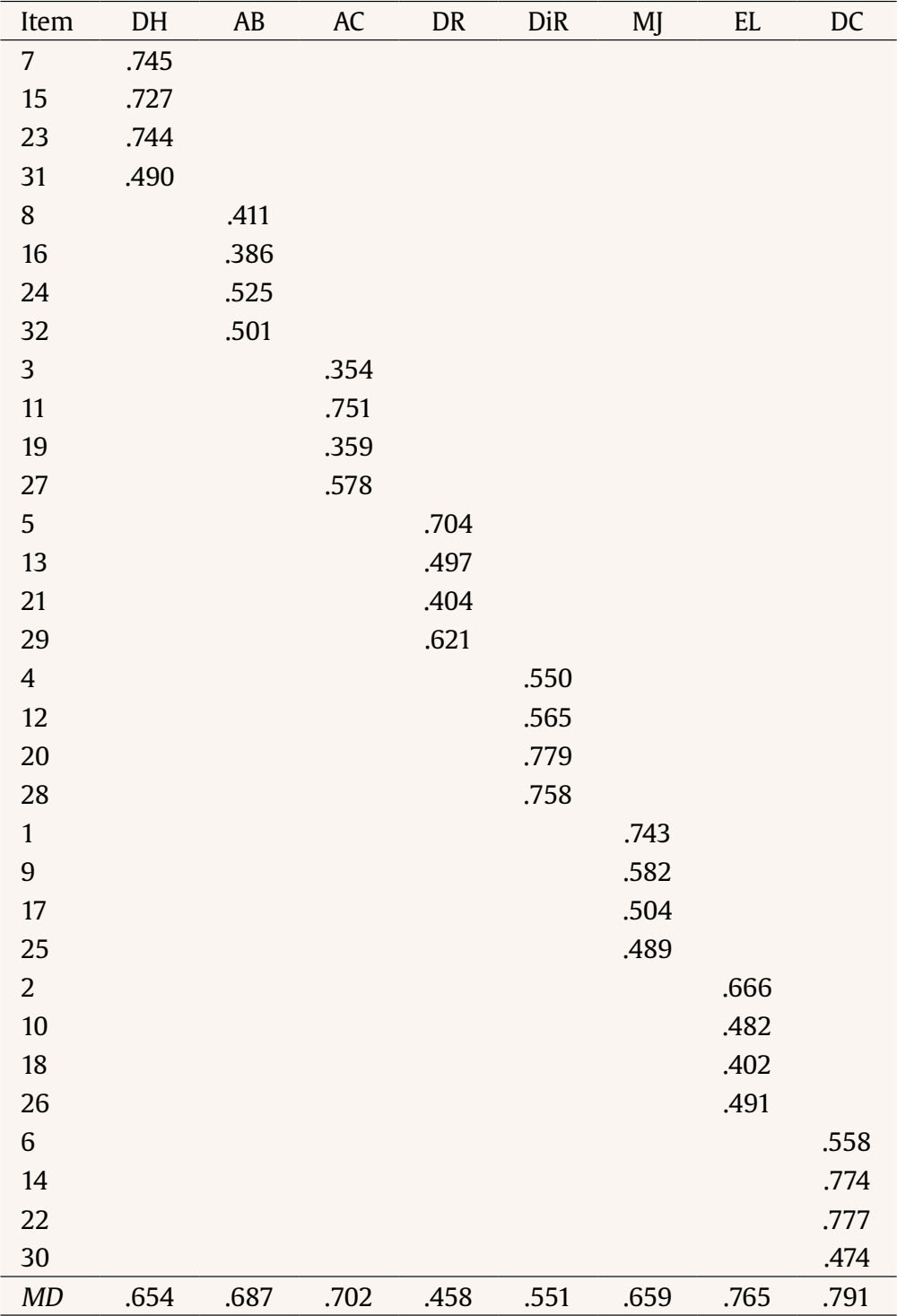 Note. MD = moral disengagement; DH = dehumanization; AB = attribution of blame; AC = advantageous comparison; DR = displacement of responsibility; DiR = diffusion of responsibility; MJ = moral justification; EL = euphemistic labeling; DC = distortion of consequences. Model 3 did not show optimal absolute goodness-of-fit indicators (chi-square = 183.558, p < .05, RMSEA = .096 < .04); the parsimony index χ2/df did not perform optimally either. However, in the incremental indices it had optimal results (AGFI = .914 > .90, TLI = .912 > .90, CFI = .959 > .95) and in the replicability potential index (ECVI = .161 < 1). Model 4 has adequate absolute goodness-of-fit indicators (chi-square = 12.514, p = .326 > .05, RMSEA= .010 < .04). It also has optimal incremental fits (AGFI = .993 > .95, TLI = .999 > .95, CFI = 1 > .95) and an optimal parsimony index (χ2/df = 1.138 <3). In addition, its replicability potential index improves with respect to Model 3 (ECVI = .044 < 1). This is a first-order model, where the observable variables are defined by the eight moral disengagement mechanisms. The CFA establishes that the eight-factor structure manages to explain the 54.173% of the total variance of the model. In addition to the goodness-of-fit indicators, it is also observed that all items had a saturation greater than .350 in all factors, which also validates the selection of Model 4 as the appropriate one for further analysis. Regarding the final saturation of the variables, it was observed that the variable with the highest saturation was distortion of consequences (DC) with a final loading of .791; the variable with the lowest factor loading was displacement of responsibility, with a saturation of .458. These results are shown in Table 2. Test for the Invariance Figure 2 shows the diagram of Model 4 with their respective standardized regression weights, which were significant at the .001 level with values above .04. This figure also shows the standardized coefficients of determination, where it is observed that all estimates were significant (p < .001) with values between .21 and .63. Reliability of Dimensions and Total Scale Regarding the reliability of the scale, two strategies were applied. The first was to consider the total scale without dimensions, and the second was the reliability coefficient for each of the moral disengagement mechanisms. Following the recommendations of Viladrich et al. (2017), the first was calculated with Cronbach’s alpha (α) and the second with the Omega coefficient (ω). The results in Table 3 show adequate reliability values both for each dimension and for the total scale. Tabla 4 Goodness-of-fit Indices for Sex, Age Range, and City Were Tested in Factorial Invariance  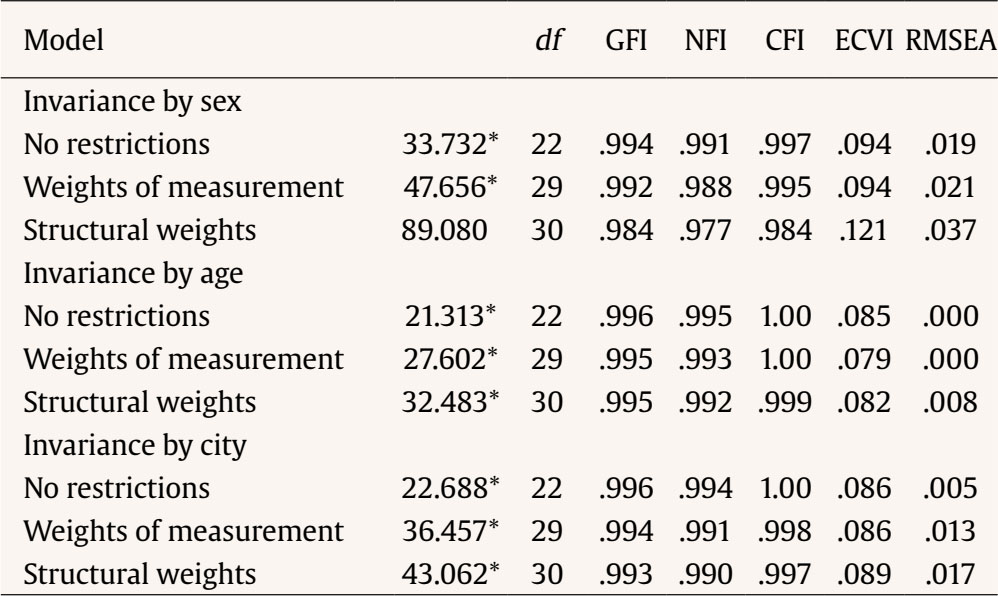 *p > .05. Test for the Invariance of Factor Structure between Subsamples An analysis of the constructs established in Model 4 was carried out to check that they had the same meaning when the sample was divided into two subgroups, in this case divided by sex, age range, and city. To this end, an analysis of invariance in the factor structure was carried out in each subgroup considered (Byrne, 2008). Table 4 shows the fit indices obtained. The results in Table 4 support the hypothesis that the baseline measurement model is invariant by sex, age, and city. In these cases the result (χ2/df < 3) shows an adequate value of invariance for the unrestricted model, as well as the general fit index (GFI), the normed fit index (NFI), the comparative fit index (CFI), and the ECVI and RMSEA indicators. Subsequently, by adding restrictions on the factor loadings (measurement weights) to the base model, incremental and absolute fit indices are observed, which show an adequate level of invariance between the two subsamples. The criterion proposed by Cheung and Rensvold (2002) states that if the difference between the CFIs of the two models is less than or equal to .01, the fact that the restricted model is good is accepted, and therefore factorial invariance is met. In this case, it was concluded that the factor loadings are equivalent in the two subsamples both for sex and by age range and city. Once the models had been analyzed, using the weights of measures, we proceeded to check the strong factorial invariance from the structural weights. The results in Table 5 show an adequate adjustment of the absolute chi-square statistic (χ2/df < 3), the other indices are also adequate; however, the criterion established by Cheung and Rensvold (2002) does not allow us to accept the hypothesis of strong invariance for the case of the subsamples of gender, but it does for the case of the subsamples of age ranges and city. Tabla 5 Non-parametric Correlations between the Studied Factors  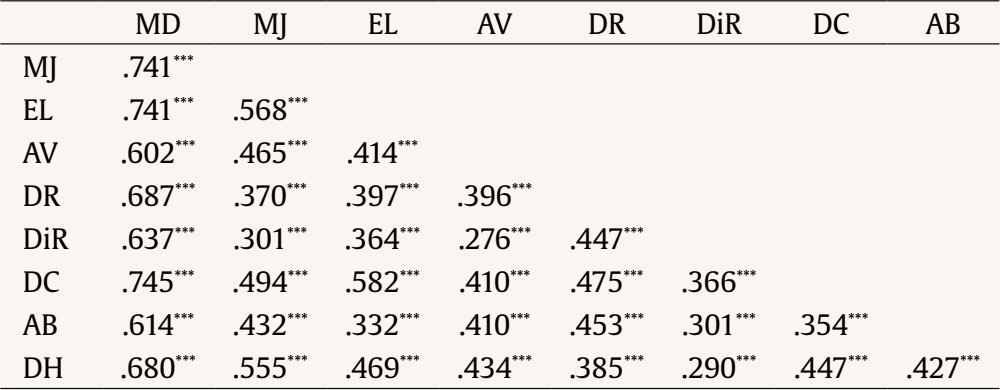 Note. MD = moral disengagement; MJ = moral justification; EL = euphemistic labeling; AV = advantageous comparison; DR = displacement of responsibility; DiR = diffusion of responsibility; DC = distortion of consequences; AB = attribution of blame; DH = dehumanization. ***p < .001. Correlations between Factors To assess construct validity, correlations between the eight variables (mechanisms) and the total scale (moral disengagement construct) were examined. Significant correlations (p < .001) were found between the moral disengagement construct and the specific mechanisms (moral justification, euphemistic language, advantageous comparison, displacement of responsibility, diffusion of responsibility, distortion of consequences, advantageous comparison, dehumanization). The overall index validating these correlations was calculated using Cronbach’s alpha, including all eight mechanisms. The result obtained was .851, which supports construct validity (Grimm & Widaman, 2012). Finally, to provide additional evidence of validity, a correlation analysis was conducted between the mechanisms of moral disengagement and the dimensions of empathy (IRI) and prosocial tendencies (PTM-R). These correlations were studied by calculating Spearman’s rho correlation coefficient. The results in Table 6 show that the eight mechanisms of moral disengagement have statistically significant correlations with almost all the dimensions of the IRI and the PTM-R. Altruistic prosocial motivation presented the highest number of significant correlations, with a negative sign, with the mechanisms of moral disengagement. Tabla 6 Non-parametric Correlations between the Mechanisms of Moral Disengagement, the Dmensions of Empathy (IRI), and the Prosocial Tendencies (PTM-R)  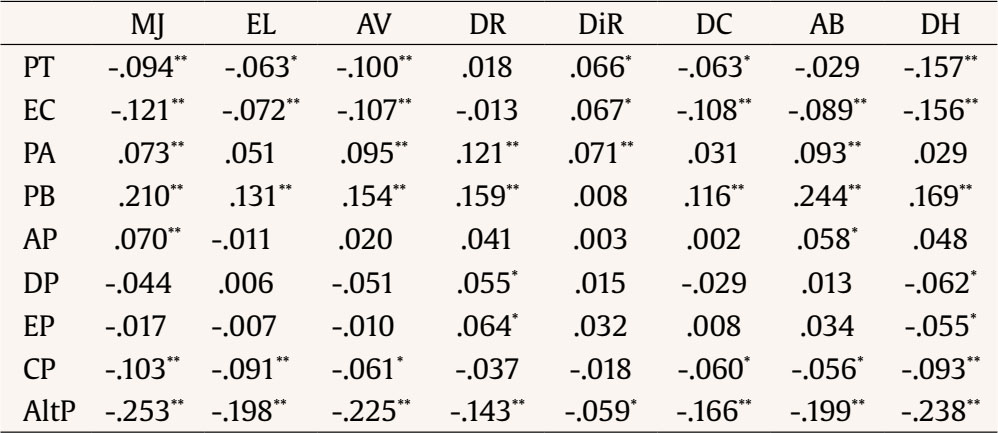 Note. MJ = moral justification; EL = euphemistic language; AV = advantageous comparison; DR = displacement of responsibility; DiR = diffusion of responsibility; DC = distortion of consequences; AB = attribution of blame; DH = dehumanization; PT = perspective taking; EC = empathic concern; PA = personal distress; PB = public prosocial behavior; AP = Anonymous prosocial behavior; DP = dire prosocial behavior; EP = emotional prosocial behavior; CP = compliant prosocial behavior; AltP = altruistic prosocial behavior. *p < .05, **p < .01. The objectives of this study were to analyze the factorial structure, psychometric characteristics, sex, age, and city invariance of the Mechanisms of Moral Disengagement Scale in young Colombian university students. The correlations between moral disengagement mechanisms, prosocial tendencies, and empathy were also analyzed. The results yielded reliable and valid measures to evaluate the set of mechanisms of moral disengagement in young university students. A first-order model was corroborated, which was invariant for sex, age, and city. This model, made up of the eight mechanisms of moral disengagement (Model 4), obtained good indicators of goodness of fit and adequate reliability indices. The factorial solution of Model 4 demonstrated the multidimensionality of the moral disengagement construct and the possibility of analyzing it based on the different specific mechanisms of moral disengagement in young university students in Colombia. These findings are consistent with various adaptation and validation studies in different social contexts, which show that moral disengagement presents a multidimensional structure that can be analyzed based on individual socio-cognitive mechanisms (Boardley et al., 2018; Corrion et al., 2010; C. Lee et al., 2014; Osofsky et al., 2005; Page et al., 2015; Rubio-Garay et al., 2017). Model 4 is compatible and conforms to the theoretical description proposed by Bandura (1999, 2002) regarding the distribution and number of socio-cognitive mechanisms of moral disengagement. However, it was not possible to corroborate a second-order factorial structure that would allow the mechanisms to be grouped in the three domains proposed by Rubio-Garay et al. (2017). Additionally, other studies have documented that moral disengagement is a one-dimensional construct (Bandura et al., 1996; Caprara et al., 2009; Gini, Pozzoli, & Bussey, 2014; Page et al., 2015; Pelton et al., 2014), an aspect that could not be corroborated in this study because the one-factor model (Model 1) did not yield good indicators of goodness of fit. The diversity of findings regarding construct dimensionality shows that moral disengagement can be understood in two ways. The first is that the elements that measure the different strategies of moral disengagement can be analyzed in isolation and operate as independent cognitive orientations to justify disruptive behaviors, an aspect that is supported by findings that demonstrate the multidimensionality of the construct. The second is that the set of moral disengagement mechanisms could be linked to a common latent trait or a unique cognitive orientation that makes people more or less likely to use these socio-cognitive strategies to justify their actions. The findings of this study showed that the factorial solution of Model 4 was invariant by sex, age, and city in Colombian university students, which indicates that the evaluation measure can be applied to different age and gender groups in both Colombian cities. These results on the factorial invariance (sex, age, and city) of the scale in young university students from Manizales and Medellín (Colombia) are considered to provide novel information by responding to the limitations reported in the study by Rubio-Garay et al. (2017). The invariance of sex in the evaluation measures of moral disengagement for different social contexts in adolescents and adults has been reported in various studies (Boardley et al., 2018; Corrion et al., 2010; Gini, Pozzoli, & Bussey, 2014; Kollerová et al., 2018). Additionally, a correlation analysis was carried out with a set of theoretically significant constructs, associated with people’s social behavior. The significant correlations between the mechanisms of moral disengagement and the components of empathy and the different prosocial tendencies provide evidence of additional validity for the evaluation measure. These results are consistent with various studies that have shown that moral disengagement has a direct negative effect on the cognitive and affective domains of empathy and prosocial behaviors (Frick & White 2008; Gini et al., 2007; Gómez & Narváez, 2019; Hyde et al., 2010; Kokkinos & Kipritsi, 2017). In this regard, Bandura et al. (1996) reported that moral disengagement is positively correlated with aggressive and criminal behavior, and negatively associated with prosocial behavior. These complementary findings show that empathy and prosocial tendencies, especially altruistic motivation, are protective factors against the use of different socio-cognitive strategies of moral disengagement in university students from both cities. Conclusions Finally, it can be concluded that, given the multidimensional hierarchical structure, this instrument can be used to measure moral disengagement using the eight mechanisms proposed by Bandura (1990, 1999, 2002). The validity and factorial invariance tests suggest that this self-report scale can be applied to college students of both sexes. The findings presented also indicate that the use of these socio-cognitive mechanisms in university students is negatively associated with empathy and prosocial behaviors. Conflict of Interest The authors of this article declare no conflict of interest. Cite this article as: Gómez-Tabares, A. S., Nuñez, C., Grisales-Aguirre, A. M., Zapata-Lesmes, G., & Arango-Tobón, O. E. (2023). Confirmatory factor analysis and factorial invariance of the mechanisms of the moral disengagement scale. Anuario de Psicología Jurídica, 34, 75-84. https://doi.org/10.5093/apj2023a10 References |
Cite this article as: Gómez-Tabares, A. S., Nuñez, C., Grisales-Aguirre, A. M., Zapata-Lesmes, G., & Arango-Tobón, O. E. (2024). Confirmatory Factor Analysis and Factorial Invariance of the Mechanisms of the Moral Disengagement Scale. Anuario de Psicolog├şa Jur├şdica, 34(1), 75 - 84. https://doi.org/10.5093/apj2023a10
Correspondence: cnunez@udemedellin.edu.co (C. Núñez)Copyright © 2026. Colegio Oficial de la Psicología de Madrid


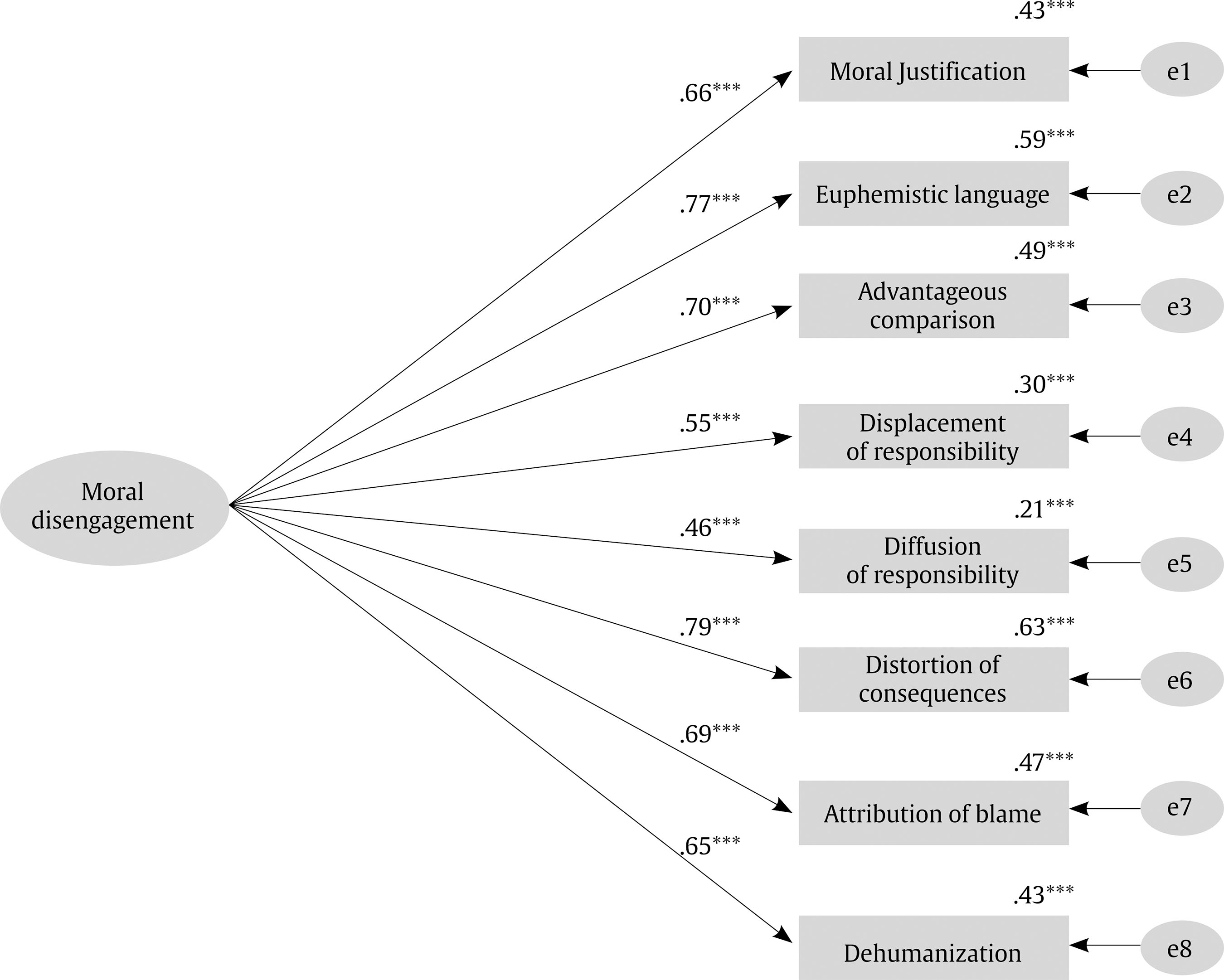

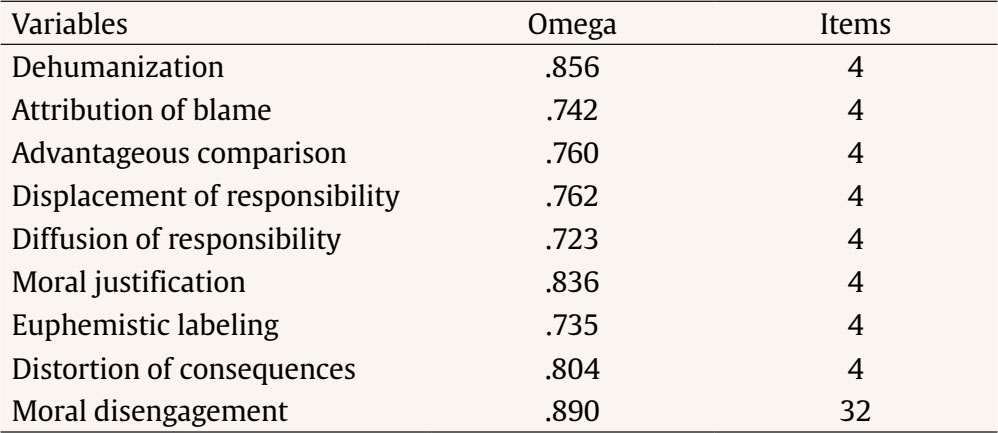






 e-PUB
e-PUB CrossRef
CrossRef JATS
JATS







